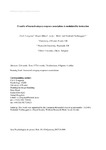Transfer of learned category-response associations is modulated by instruction
| dc.contributor.author | Longman, CS | |
| dc.contributor.author | Milton, F | |
| dc.contributor.author | Wills, Andy | |
| dc.contributor.author | Verbruggen, F | |
| dc.date.accessioned | 2017-04-19T08:05:25Z | |
| dc.date.available | 2017-04-19T08:05:25Z | |
| dc.date.issued | 2017-04-25 | |
| dc.identifier.issn | 0001-6918 | |
| dc.identifier.issn | 1873-6297 | |
| dc.identifier.uri | http://hdl.handle.net/10026.1/9082 | |
| dc.description.abstract |
Although instructions often emphasize categories (e.g., odd number→left hand response) rather than specific stimuli (e.g., 3→left hand response), learning is often interpreted in terms of stimulus-response (S-R) bindings or, less frequently, stimulus-classification (S-C) bindings with little attention being paid to the importance of category-response (C-R) bindings. In a training-transfer paradigm designed to investigate the early stages of category learning, participants were required to classify stimuli according to the category templates presented prior to each block (Experiments 1-4). In some transfer blocks the stimuli, categories and/or responses could be novel or repeated from the preceding training phase. Learning was assessed by comparing the transfer-training performance difference across conditions. Participants were able to rapidly transfer C-R associations to novel stimuli but evidence of S-C transfer was much weaker and S-R transfer was largely limited to conditions where the stimulus was classified under the same category. Thus, even though there was some evidence that learned S-R and S-C associations contributed to performance, learned C-R associations seemed to play a much more important role. In a final experiment (Experiment 5) the stimuli themselves were presented prior to each block, and the instructions did not mention the category structure. In this experiment, the evidence for S-R learning outweighed the evidence for C-R learning, indicating the importance of instructions in learning. The implications for these findings to the learning, cognitive control, and automaticity literatures are discussed. | |
| dc.format.extent | 144-167 | |
| dc.format.medium | Print-Electronic | |
| dc.language | en | |
| dc.language.iso | en | |
| dc.publisher | Elsevier BV | |
| dc.subject | Instructed learning | |
| dc.subject | S-R learning | |
| dc.subject | Automaticity | |
| dc.subject | Cognitive control | |
| dc.subject | Categorization | |
| dc.title | Transfer of learned category-response associations is modulated by instruction | |
| dc.type | journal-article | |
| dc.type | Journal Article | |
| plymouth.author-url | https://www.webofscience.com/api/gateway?GWVersion=2&SrcApp=PARTNER_APP&SrcAuth=LinksAMR&KeyUT=WOS:000429510800014&DestLinkType=FullRecord&DestApp=ALL_WOS&UsrCustomerID=11bb513d99f797142bcfeffcc58ea008 | |
| plymouth.volume | 184 | |
| plymouth.publication-status | Published | |
| plymouth.journal | Acta Psychologica | |
| dc.identifier.doi | 10.1016/j.actpsy.2017.04.004 | |
| plymouth.organisational-group | /Plymouth | |
| plymouth.organisational-group | /Plymouth/Admin Group - REF | |
| plymouth.organisational-group | /Plymouth/Admin Group - REF/REF Admin Group - FoH | |
| plymouth.organisational-group | /Plymouth/Faculty of Health | |
| plymouth.organisational-group | /Plymouth/Faculty of Health/School of Psychology | |
| plymouth.organisational-group | /Plymouth/REF 2021 Researchers by UoA | |
| plymouth.organisational-group | /Plymouth/REF 2021 Researchers by UoA/UoA04 Psychology, Psychiatry and Neuroscience | |
| plymouth.organisational-group | /Plymouth/Research Groups | |
| plymouth.organisational-group | /Plymouth/Research Groups/Institute of Health and Community | |
| plymouth.organisational-group | /Plymouth/Users by role | |
| plymouth.organisational-group | /Plymouth/Users by role/Academics | |
| dc.publisher.place | Netherlands | |
| dcterms.dateAccepted | 2017-04-11 | |
| dc.rights.embargodate | 2018-10-25 | |
| dc.identifier.eissn | 1873-6297 | |
| dc.rights.embargoperiod | 18 months | |
| rioxxterms.versionofrecord | 10.1016/j.actpsy.2017.04.004 | |
| rioxxterms.licenseref.uri | http://www.rioxx.net/licenses/under-embargo-all-rights-reserved | |
| rioxxterms.licenseref.startdate | 2017-04-25 | |
| rioxxterms.type | Journal Article/Review |


